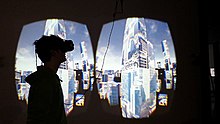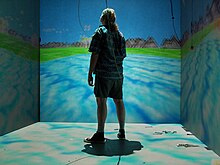Immersion (virtual reality)


Immersion describes the effect caused by a virtual reality (VR) environment , which makes the user's awareness of being exposed to illusory stimuli so far into the background that the virtual environment is perceived as real. If the degree of immersion is particularly high, “presence” is also used.
In contrast to passive, cinematic immersion, virtual reality allows interaction with the virtual environment, whereby a significantly higher intensity of immersion can be achieved.
There is talk of an immersive virtual environment ( immersive virtual environment ) if it is possible for the user to interact directly with this. The CAVE with the corresponding interaction hardware is an example of such a system. In contrast to this is the non-immersive virtual reality, e.g. B. in a 3D CAD system which is operated on a PC.
Presentation of immersion in 1926
Without knowing the terms immersion and virtual reality , the journalist Ludwig Kapeller described exactly that as early as 1926 on the occasion of the first successful attempts at television broadcasting:
- “The radio of tomorrow: a push of the button and rushing sound, with depths and perspectives; and another pressure: moving image, sound and sound illustrating, a turn of the lever, and England comes, boxing match in London, with cracks of fists and groans of pain, with the quick gestures of the fighters; or America comes in, with jazz band syncopation and the black faces of the 'chocolate kiddies'; or Rome with Verdiklänge, with the colorful pictures of Italian operas. Or suddenly, eerie, we experience ghastly in the '505', staged somewhere by a sea-lashing radio director, with sirens wailing and waves crashing, with screams of despair, a sinking of the 'Titanic', nocturnal image of human agony. And the day after tomorrow maybe: the plastic, colored, speaking radio film, capturing experience with all the senses and mastering it through technology that reveals itself to millions of those hungry for experience by pressing a black button. "
Immersion in computer games
In the discourse of game design, the term immersion describes a gamer's experience of being in a virtual world.
Captivating and sophisticated virtual worlds lead to greater immersion, as do control devices ( controllers ) that allow a natural-looking interaction with the virtual world. In extreme cases, this can mean that players have to get used to the real world again after the end of the VR game. The intensity also depends on the personality of the player and the duration of the game.
The American professor of digital media Janet H. Murray describes immersion as follows:
“The experience of being transported to an elaborately simulated place is pleasurable in itself, regardless of the fantasy content. Immersion is a metaphorical term derived from the physical experience of being submerged in water. We seek the same feeling from a psychologically immersive experience that we do from a plunge in the ocean or swimming pool: the sensation of being surrounded by a completely other reality, as different as water is from air, that takes over all of our attention, our whole perceptual apparatus. "
“The experience of being transported into an elaborately simulated environment is pleasant in itself, regardless of the fantastic content. Immersion is a metaphorical term derived from the physical experience of being submerged in water. We are looking for the same feeling of a psychologically immersive experience as we would expect from a dip in the sea or the swimming pool: the feeling of being surrounded by a completely different reality, as different as the relationship between the water and the air, that draws our entire attention draws our entire perceptual apparatus. "
Richard Bartle distinguishes four different levels of immersion :
- player : The game character is a means of influencing the game world.
- avatar : The character is a representative of the player in the game world. Players talk about the character in the third person.
- character : Computer players identify with the character and speak about them in the first person.
- persona : The game character is part of the identity of the computer player. He does not play a character in a virtual world, he is himself in a virtual world.
The computer game genre of the first-person shooter , for example, is basically played from the perspective of the game character, i.e. from the first-person perspective . The game designers use immersion here to allow the player to experience the virtual world as directly as possible.
Immersion in role play
In the pen - & - paper role-playing game (P & P) and live role-playing (LARP) immersion is a key issue. It is about offering the player the most believable and intense experience of the game world. In the P&P role-playing game, this is primarily achieved through the story leader's narrative skills. Furthermore, through a set of rules that summarize the game world as credibly as possible in terms of values, game rules and background stories. In live role-playing games, immersion is brought about by appropriate cladding and surroundings. For example, in a fantasy LARP, the players would dress up as warriors, elves , orcs and so on. You would possibly play in a rented castle or a manor and there - similar to what is common in medieval markets - put away and hide everything that does not match the medieval / fantasy background (e.g. plastic bottles).
In this way, the players manage to escape their real world for a few hours and during this period of time to represent another (mostly self-chosen) person. Through the experience of acting together, the players simultaneously experience the life of another character and the reactions of those around them.
When portraying role play in film and television, the danger posed by immersion that may be too intense for unstable people is also regularly addressed. A typical example of this is the 1982 film Labyrinth of the Monsters, starring Tom Hanks , which was shot during the heyday of “pen and paper” role-playing games.
Taking up immersion in literature and film
Examples for taking up the terms and concepts of “immersion” and “immersion in virtual reality” as well as for feeling and understanding reality in literature and film.
- 380 BC Chr .: Plato's allegory of the cave : "What if our perceived environment is only a shadow of a higher reality."
- 1641: Meditations on the basics of philosophy ( Descartes ) - senses do not provide any fundamental knowledge, see rationalism
- 1964: Simulacron-3 ( Daniel F. Galouye ) - when creating and visiting a virtual world, a path opens into the world that created our world virtually; last filmed as The 13th Floor
- 1971: The futurological congress ( Stanislaw Lem ) - using psychoactive chemicals ("psychemia") virtual worlds with paradisiacal states are created, but the facade crumbles
- 1973: Welt am Draht ( Rainer Werner Fassbinder ) - in a VR project, the successor of the deceased project manager realizes that he himself is only a simulation, see Simulacron-3
- 1982: Tron (Steven Lisberger) - coined ideas about a virtual reality, trapped in the computer (strictly speaking no immersion, but the actual transfer of the person into the virtual world)
- 1982: Labyrinth of the Monsters (Steven Hilliard Stern) - A film about pen and paper role-playing games in which one of the players mixes up game and reality over time.
- 1984: Neuromancer ( William Gibson ) - basis of cyberpunk and cyberspace with a direct connection to the brain
- 1986: Star Trek TNG ( Gene Roddenberry ) - holographic spaces that create a tangible virtual reality around the viewer, often humans or AIs do not know that they are in a virtual world
- 1988: Red Dwarf - British sitcom with VR elements
- 1991: Foundation cycle ( Isaac Asimov ) - holographic rooms (including toilets) for relaxation
- 1991: Snow Crash ( Neal Stephenson ) - postmodern cyberpunk satire
- 1992: The lawnmower man - action thriller, virtual reality for behavior change
- 1994: Sam and Dave - two shooters on a diving station (Rafal Zielinski) - comedy, mixed with virtual reality in reality
- 1996: Otherland ( Tad Williams ) - fantasy novel in which the characters dive into a virtual world and fight there for the survival of many sick children
- 1998: The Truman Show ( Peter Weir ) - reality show Satire, a real world was created under a huge dome, only for the main character, virtually virtually
- 1999: The Matrix ( Wachowski siblings ) - action thriller, machine-bred humans break out of their virtual reality, which is only for their control
- 1999: The 13th Floor - science fiction film, people in a virtual world build a second virtual environment before they become aware of their own virtuality, see Simulacron-3 and Welt am Draht .
- 1999: eXistenZ - "You are the game" by David Cronenberg - cryptically arranged story about a computer game that begins with a bioport and an organic console with several levels of reality
- 2001: Avalon - Game for Your Life by Mamoru Oshii - Illegal VR game turns its participants into mental cripples from a certain level
- 2001: Spy Kids ( Robert Rodriguez ) - youth-free action, with VR elements
- 2001: Digimon ( Bandai ) - computer game and anime series that takes place almost entirely in a virtual world
- 2002: .hack (dot hack) - Japanese anime series in which players immerse themselves in the virtual world of the MMORPG The World as characters using Oculus Rift-like glasses . Some players are unable to leave the game due to bugs .
- 2011: Ready Player One (novel) - novel and film, dystopian world in which the main characters dive into a virtual world
- 2012: Sword Art Online - anime series whose main plot in a computer game takes place in the one of using VR helmet arrives
- 2012: Hikikomori ( Kevin Kuhn ) - novel in which the main character gradually drifts into a virtual world that is experienced like reality
Individual evidence
- ↑ 10,000 Moving Cities - Same but Different, Interactive network- and telepresence-based installation, 2016 .
- ^ Ludwig Kapeller: Rundfunk von Morgen , in Uhu , Ullstein Berlin October 1926, p. 70
- ↑ Hands can feel so real in VR . Video from 1:45.
- ↑ Janet H. Murray: Hamlet on the Holodeck: The Future Of Narrative In Cyberspace . Free Press, New York 1997, ISBN 978-0-684-82723-0 , pp. 98 f .
- ^ Richard A. Bartle: Designing Virtual Worlds . New Riders, Indianapolis 2004, pp. 154-158.
- ↑ Rainer Sigl: This subtle feeling of fear. In: Telepolis. January 10, 2006, accessed December 6, 2017 .
literature
- Oliver Grau : Virtual Art. From Illusion to Immersion . MIT Press, Cambridge 2003, ISBN 0-262-07241-6 .
- Stefanie Menrath, Alexander Schwinghammer (eds.): What Does a Chameleon Look Like? Topographies of Immersion . Herbert von Halem Verlag, Cologne 2011, ISBN 978-3-938258-51-4 .
- Sonja Klimek: Illusion, immersion and identification in narrative role-playing . In: Colloquium Helveticum. Yearbook of the Swiss Society for General and Comparative Literature , 43 (2012), pp. 244–266.
Web links
- Immersion and interaction. From circular frescoes to interactive pictorial space
- Web room Will there still be websites in the Internet of the future, or maybe rather web rooms ... (Internet VR demo for Oculus Rift, HTC Vive and Google Cardboard)
